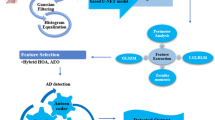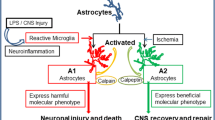Summary
Neurofilaments, part of the cytoskeletal network, and neuron specific enolase, a major enzyme in glycolysis, are both present in central and peripheral neurons. Glial fibrillary acidic protein and S-100, on the other hand, are soluble proteins which are found exclusively in the supportive cells of the nervous system, i.e. the glial cells.
Examination was made, using immunocytochemistry, of all main areas of the gastrointestinal tract of three mammalian species, rat, pig and man. By applying serial tissue sectioning, it was possible to study the relative occurrences of the two neuronal markers in the same cell bodies and to examine the relationships of the neurons with the glial cells as revealed by the antibodies to glial fibrillary acidic protein and S-100.
Both neurofilaments and neuron specific enolase were localised to an extensive system of enteric nerves, with the level of neuron specific enolase-immunoreactivity showing greater variability than that observed using antibodies to neurofilaments. Comparison of the occurrence of neuron specific enolase and neurofilament immunoreactivity in serially sectioned neuronal cell bodies revealed that a minor population stained only with antibodies to neurofilaments. The equivocal or absent neuron specific enolase-immunoreactivity in some perikarya may reflect variations in functional status within the nervous system. Glial fibrillary acidic protein- and S-100-immunoreactivities were confined to glial cells which, in this normal tissue, were always in close association with the neurons.
In conclusion, neurofilament-, glial fibrillary acidic protein-and S-100-immunostaining can be used to reveal the enteric nervous system and its supportive cells in these three mammals. The combined use of all these neuronal and non-neuronal markers may be helpful in delineating the enteric nervous system and assessing its morphological and functional status.
Similar content being viewed by others
References
Bishop AE, Polak JM, Bloom SR, Pearse AGE (1978) A new universal technique for the immunocytochemical localisation of peptidergic innervation. J Endocrinol 77:25–26p
Bishop AE, Polak JM, Facer P, Ferri GL, Marangos PJ, Pearse AGE (1982) Neuron specific enolase: a common marker for endocrine cells and innervation of the gut and pancreas. Gastroenterology 83:902–912
Bishop AE, Polak JM, Yiangou Y, Christofides ND, Bloom SR (1984) The distributions of PHI and VIP in porcine gut and their co-localisation to a proportion of intrinsic ganglion cells. Peptides 5:255–260
Bjorklund H, Dahl D, Seiger A (1984) Neurofilament and glial fibrillary acid protein-related immunoreactivity in rodent enteric nervous system. Neuroscience 12:277–287
Chiu FC, Korey B, Norton WT (1980) Intermediate filaments from bovine, rat and human CNS: Mapping analysis of the major proteins. J Neurochem 34:1145–1159
Coons AH, Leduc EH, Connolly J (1955) Studies of antibody production. J Exp Med 102:49–60
Dahl D, Bignami A (1976) Immunogenic properties of the glial fibrillary acidic protein. Brain Res 116:150–157
Dahl D, Bignami A (1977) Preparation of antisera to neurofilament protein from chicken brain and human sciatic nerve. J Comp Neurol 176:645–658
Dahl D, Chi NH, Miles LE, Nguyen BT, Bignami A (1982a) Glial fibrillary acidic (GFA) protein in Schwann cells: fact or artefact? J Histochem Cytochem 30:912–918
Dahl D, Sellcoe DJ, Pero RT, Bignami A (1982b) Immunostaining of neurofibrillary tangles in Alzheimer's senile dementia with a neurofilament antiserum. J Neurosci 2:113–119
Davison PF, Jones RN (1980) Neurofilament proteins of mammals compared by peptide mapping. Brain Res 192:470–473
Ferri GL, Probert L, Cocchia D, Michetti F, Marangos PJ, Polak JM (1982) Evidence for the presence of S-100 protein in the glial component of the human enteric nervous system. Nature 297:409–410
Gabella G (1979) Innervation of the gastrointestial tract. Int Rev Cytol 59:129–193
Graham RC, Karnovsky MJ (1966) The early stages of absorption of injected horseradish peroxidase in the proximal tubules of mouse kidney. J Histochem Cytochem 14:291–302
Hickey WF, Lee V, Trojanowski JQ, McMillan LJ, McKearn TJ, Gonatas J, Gonatas NK (1983) Immunohistochemical application of monoclonal antibodies against myelin basic protein and neurofilament triplet protein subunits. J Histochem Cytochem 31:1126–1135
Hoffman PN, Lasek RJ (1975) The slow component of axonal transport. Identification of major structural polypeptides of the axon and their generality among mammalian neurons. J Cell Biol 66:351–366
Huang WM, Gibson SJ, Facer P, Gu J, Polak JM (1983) Improved section adhesion for immunocytochemistry using high molecular weight polymers of l-lysine as a slide coating. Histochemistry 77:275–279
Jessen KR, Mirsky R (1980) Glial cells in the enteric nervous system contain glial fibrillary acidic protein. Nature 286:736–737
Kluck P, Van Muijen GNP, Van der Kamp WM, Tibboel D, Van Hoorn WA, Warnaar SO, Molenaar JC (1984) Hirschsprung's disease studied with monoclonal antineurofilament antibodies on tissue sections. Lancet 1:652–653
Lazarides E (1982) Intermediate filaments: a chemically heterogeneous, developmentally regulated class of proteins. Annu Rev Biochem 51:219–250
Marangos PJ, Schmechel D, Parma AM, Clark RL, Goodwin FK (1979) Measurement of neuron-specific (NSE) and non-neuronal (NNE) isoenzymes of enolase in rat, monkey and human nervous tissue. J Neurochem 33:319–329
Moore BW (1972) Chemistry and biology of two proteins, S-100 and 14-3-2, specific to the nervous system. Int Rev Neurobiol 15:215–225
Schmechel D, Marangos PJ, Brightman M (1978) Neuron specific enolase is a molecular marker for peripheral and central neuroendocrine cells. Nature 276:834–836
Sharp GA, Shaw G, Weber K (1982) Immunoelectron microscopical localisation of the three neurofilament triplet proteins along neurofilaments of cultured dorsal root ganglion neurones. Exp Cell Res 137:403–413
Smith B (1972) The neuropathology of the alimentary tract. Arnold, London
Sternberger LA (1979) The unlabelled antibocy peroxidase antiperoxidase (PAP) method. Immunocytochemistry. John Wiley, New York, pp 104–169
Author information
Authors and Affiliations
Rights and permissions
About this article
Cite this article
Bishop, A.E., Carlei, F., Lee, V. et al. Combined immunostaining of neurofilaments, neuron specific enolase, GFAP and S-100. Histochemistry 82, 93–97 (1985). https://doi.org/10.1007/BF00502095
Received:
Issue Date:
DOI: https://doi.org/10.1007/BF00502095




